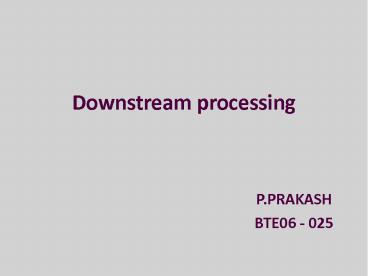Downstream processing - PowerPoint PPT Presentation
Title:
Downstream processing
Description:
Downstream processing P.PRAKASH BTE06 - 025 Downstream processing The various stages of processing that occur after the completion of the fermentation or ... – PowerPoint PPT presentation
Number of Views:268
Avg rating:3.0/5.0
Title: Downstream processing
1
Downstream processing
- P.PRAKASH
- BTE06 - 025
2
Downstream processing
- The various stages of processing that occur after
the completion of the fermentation or
bioconversion stage, including separation,
purification, and packaging of the product
3
Stages in Downstream Processing
- Removal of insoluble's
- Product Isolation
- Product Purification
- Product Polishing
4
Removal of insoluble's
- capture of the product as a solute in a
particulate-free liquid - Example
- separation of cells, cell debris or other
particulate matter from fermentation broth
containing an antibiotic.
5
Typical operations
- Filtration
- A mechanical operation used for the separation of
solids from fluids (liquids or gases) by
interposing a medium to fluid flow through which
the fluid can pass, but the solids in the fluid
are retained.
6
Filter media
- two main types of filter media are
- solid sieve which
- -traps the solid particles
- bed of granular materials
- -retains the solid particles
7
- Points to be considered while selecting the
filter media - ability to build the solid.
- minimum resistance to flow the filtrate.
- resistance to chemical attack.
- minimum cost.
- long life
8
Centrifugation
- use of the centrifugal force for the separation
of mixtures - More-dense components migrate away from the axis
of the centrifuge - less-dense components migrate towards the axis.
9
Flocculation
- process where a solute comes out of solution in
the form of flocs or flakes. - Particles finer than 0.1 µm in water remain
continuously in motion due to electrostatic
charge which causes them to repel each other - Once their electrostatic charge is neutralized
(use of coagulant) the finer particles start to
collide and combine together . - These larger and heavier particles are called
flocs.
10
Product Isolation
- reducing the volume of material to be handled and
concentrating the product. - the unit operations involved
- -Solvent extraction
- -ultra filtration
- -precipitation
11
Precipitation
- formation of a solid in a solution during a
chemical reaction. - solid formed is called the precipitate and the
liquid remaining above the solid is called the
supernate.
12
Product Purification
- To separate contaminants that resemble the
product very closely in physical and chemical
properties. - Expensive and require sensitive and sophisticated
equipment.
13
Crystallization
- process of formation of solid crystals
precipitating from a solution, melt or more
rarely deposited directly from a gas. - chemical solid-liquid separation technique, in
which mass transfer of a solute from the liquid
solution to a pure solid crystalline phase occurs.
14
Product Polishing
- final processing steps which end with packaging
of the product in a form that is stable, easily
transportable and convenient. - Crystallization, desiccation, lyophilization and
spray drying are typical unit operations
15
lyophilization
- freezing the material
- reducing the surrounding pressure and adding
enough heat to allow the frozen water in the
material to sublime directly from the solid phase
to gas.
16
THANK U































